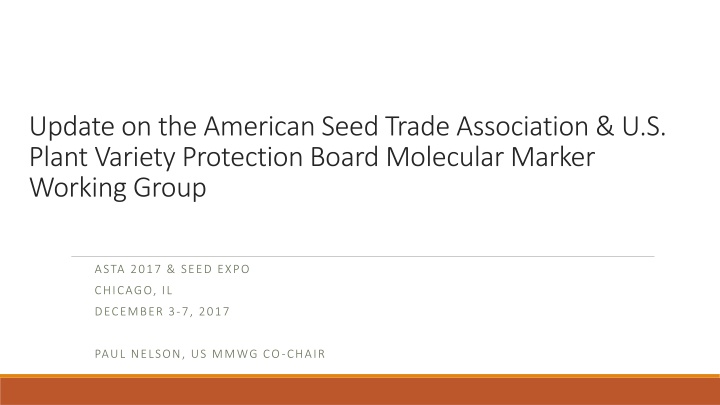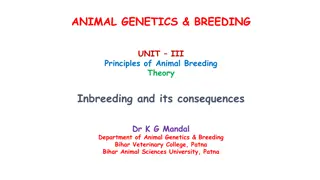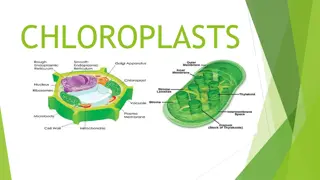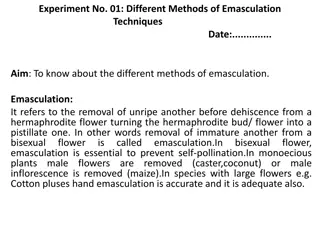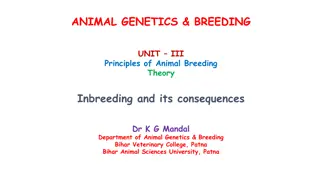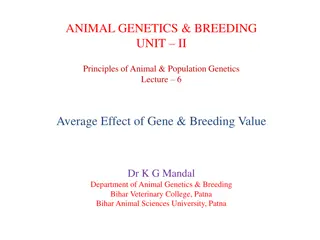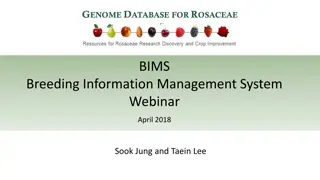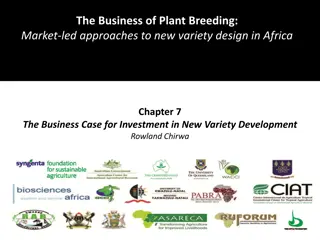Advancements in Molecular Marker Utilization for Plant Breeding
Explore the latest developments in using DNA markers for plant breeding, focusing on applications such as marker-trait association, germplasm characterization, and seed purity. Learn how DNA markers are revolutionizing plant science by enhancing genomic prediction, facilitating varietal distinctness determination, and accelerating breeding methods. Discover the collaborative efforts of the American Seed Trade Association and the U.S. Plant Variety Protection Board Molecular Marker Working Group in advancing innovative techniques for plant improvement.
Download Presentation

Please find below an Image/Link to download the presentation.
The content on the website is provided AS IS for your information and personal use only. It may not be sold, licensed, or shared on other websites without obtaining consent from the author.If you encounter any issues during the download, it is possible that the publisher has removed the file from their server.
You are allowed to download the files provided on this website for personal or commercial use, subject to the condition that they are used lawfully. All files are the property of their respective owners.
The content on the website is provided AS IS for your information and personal use only. It may not be sold, licensed, or shared on other websites without obtaining consent from the author.
E N D
Presentation Transcript
Update on the American Seed Trade Association & U.S. Plant Variety Protection Board Molecular Marker Working Group ASTA 2017 & SEED EXPO CHICAGO, IL DECEMBER 3-7, 2017 PAUL NELSON, US MMWG CO-CHAIR
DNA Markers in Plant Science Genomic Prediction Marker-Trait Association Germplasm Characterization Seed Purity IP Enforcement Criminal Cases
DNA Markers in DUS Gaining Momentum # Abstracts USA GEVES MMWG Reference Management CPVO UPOV BMT Session Isozymes to Complement Morphology CPVO IMODDUS NL, KR, SAA Marker WG CN DNA pre-screens
Modern Breeding Necessitates New Methods in DUS Breeding Methods: DNA markers, established heterotic pools, faster cycle time Breeding Selection Criteria: Performance (yield, agronomics, disease) DUS Criteria: Morphology (non-performance visual observation) Standard morphological descriptors often fail to establish distinctness. PVP Office asks for additional evidence. Breeder returns to field -> time, $$. DNA markers can be used to establish distinctness. Variety A D Yield 10 9 Test Weight Stalk Strength Root Strength Disease Resistance Morph. Sim. 7 5 8 8 9 6 Marker Sim. 9 7 1 0.83
Molecular Marker Working Group (MMWG) Purpose: Explore methods for using DNA markers in DUS 27 Scientists 18 Institutions (Public and Private) US PVP Board ASTA MMWG Quarterly Meetings United States Plant Variety Protection Board American Seed Trade Association Joint Molecular Marker Working Group Technical Focus
MMWG Focus - Direct Varietal Comparisons Marker similarity as supplemental evidence when standard morphological descriptor comparison is inconclusive for two varieties. Establish method and determine proper threshold for application of marker similarity. Scientifically vetted methods (peer review) Grounded in morphology Soybean first (greatest need)
UPOV BMT/16 Four MMWG talks The use of Reference Variety Similarities in Varietal Distinctness II: Reference Variety Selection Assessment of reproducibility of 6K SNP genotyping in soybean across laboratories Determining the parameters to characterize Soybean varieties using single nucleotide polymorphisms Update on the American Seed Trade Association and United States PVP Office Molecular Marker Working Group Minimal negativity toward US approach Anti-DNA marker sentiment is fading Netherlands: French Bean encouraging test-case
Next Steps Prepare final recommendation for the PVP Office/Board Global engagement: CPVO IMODDUS (EU marker working group) SAA marker working group soy harmonization BMT/17 September 2017 Additional Crops/Models THANK YOU
